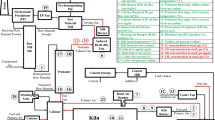Abstract
The composition of the distillation column is a very important quality value in refineries, unfortunately, few hardware sensors are available on-line to measure the distillation compositions. In this paper, a novel method using sensitivity matrix analysis and kernel ridge regression (KRR) to implement on-line soft sensing of distillation compositions is proposed. In this approach, the sensitivity matrix analysis is presented to select the most suitable secondary variables to be used as the soft sensor’s input. The KRR is used to build the composition soft sensor. Application to a simulated distillation column demonstrates the effectiveness of the method.
Similar content being viewed by others
References
M. Kano, K. Miyazaki, S. Hasebe, I. Hashimoto. Inferential Control System of Distillation Compositions Using Dynamic Partial Least Squares Regression. Journal of Process Control, vol. 10, no. 2–3, pp. 157–166, 2000.
M. Kano, N. Showchaiya, S. Hasebe, I. Hashimoto. Inferential Control of Distillation Compositions: Selection of Model and Control Configuration. Control Engineering Practice, vol. 11, no. 8, pp. 927–933, 2003.
B. Joseph, C. B. Brosilow. Inferential Control of Processes: Part I. Steady State Analysis and Design. AIChE Journal, vol. 24, no. 3, pp. 485–492, 1978.
T. Mejdell, S. Skogestad. Estimation of Distillation Compositions from Multiple Temperature Measurements Using Partial-least-squares Regression. Industrial and Engineering Chemistry Research, vol. 30, no. 12, pp. 2543–2555, 1991.
T. Mejdell, S. Skogestad. Composition Estimator in a Pilotplant Distillation Column UsingMultiple Temperatures. Industrial and Engineering Chemistry Research, vol. 30, no. 12, pp. 2555–2564, 1991.
E. Zamprogna, M. Barolo, D. E. Seborg. Estimating Product Composition Profiles in Batch Distillation via Partial Least Squares Regression. Control Engineering Practice, vol. 12, no. 7, pp. 917–929, 2004.
E. Zamprogna, M. Barolo, D. E. Seborg. Optimal Selection of Soft Sensor Inputs for Batch Distillation Columns Using Principal Component Analysis. Journal of Process Control, vol. 15, no. 1, pp. 39–52, 2005.
J. Zhang. Inferential Feedback Control of Distillation Composition Based on PCR and PLSModels. In Proceedings of the American Control Conference, IEEE Press, Arlington, VA, USA, vol. 2, pp. 1196–1201, 2001.
S. Bhartiya, J. R. Whiteley. Development of Inferential Measurements Using Neural Networks. ISA Transactions, vol. 40, no. 4, pp. 307–323, 2001.
W. Chen, J. M. Li. Adaptive Output-feedback Regulation for Nonlinear Delayed Systems Using Neural Network. International Journal of Automation and Computing, vol. 5, no. 1, pp. 103–108, 2008.
M. Chen, C. S. Jiang, Q. X. Wu. Sensor Fault Diagnosis for a Class of Time Delay Uncertain Nonlinear Systems Using Neural Network. International Journal of Automation and Computing, vol. 5, no. 4, pp. 401–405, 2008.
W. W. Yan, H. H. Shao, X. F. Wang. Soft Sensing Modeling Based on Support Vector Machine and Bayesian Model Selection. Computers and Chemical Engineering, vol. 28, no. 8, pp. 1489–1498, 2004.
A. E. Hoerl, R. W. Kennard. Ridge Regression: Biased Estimation for Non-orthogonal Problems. Technometrics, vol. 42, no.1, pp. 80–86, 2000.
A. E. Hoerl, R. W. Kennard. Ridge Regression: Application for Non-orthogonal Problems. Technometrics, vol. 12, no. 1, pp. 69–82, 1970.
C. Saunders, A. Gammerman, V. Vovk. Ridge Regression Learning Algorithm in Dual Variables. In Proceedings of the 15th International Conference on Machine Learning, Madison, Wisconsin, USA, pp. 515–521, 1998.
E. Quintero-Marmol, W. L. Luyben, C. Georgakis. Application of an Extended Luenberger Observer to the Control of Multicomponent Batch Distillation. Industrial and Engineering Chemistry Research, vol. 30, no. 8, pp. 1870–1880, 1991.
V. N. Vapnik. The Nature of Statistical Learning Theory, 2nd Edition, Springer, Berlin, Germany, 1999.
Author information
Authors and Affiliations
Corresponding author
Additional information
This work was supported by National Basic Research Program of China (973 Program) (No. 2007CB714006)
Qi Li received his B. Sc. and Ph.D. degrees in automatic control engineering at Dalian University of Technology, Dalian, PRC in 2002 and 2008, respectively. He is currently a lecturer in the Institute of Advanced Control Technology at Dalian University of Technology.
His research interests include soft sensing and optimizing control for chemical processes.
Cheng Shao graduated from Liaoning University, PRC in 1981. He received his M. Sc. and Ph.D. degrees in automatic control engineering at Northeastern University, Shenyang, PRC in 1986 and 1992, respectively. He is currently a professor in the Institute of Advanced Control Technology at Dalian University of Technology, PRC.
His research interests include robust adaptive control, intelligent learning control, and optimizing control for chemical processes.
Rights and permissions
About this article
Cite this article
Li, Q., Shao, C. Soft sensing modelling based on optimal selection of secondary variables and its application. Int. J. Autom. Comput. 6, 379–384 (2009). https://doi.org/10.1007/s11633-009-0379-x
Received:
Accepted:
Published:
Issue Date:
DOI: https://doi.org/10.1007/s11633-009-0379-x




